| Posted: Jul 05, 2010 | |
Antibacterial paper made from graphene |
|
| (Nanowerk Spotlight) Researchers have made the surprising finding that graphene-based nanomaterials possess excellent antibacterial properties. Although antibacterial materials are widely used in daily life, and the antibacterial properties of nanomaterials are increasingly being explored and developed as commercial products (see for instance: "Antibacterial nanotechnology multi-action materials that work day and night"), their cytotoxicity and biocompatibility has raised questions and concerns. | |
| So far, biological studies of graphene have been relatively limited. Although a a very recent study ("Biocompatible, Robust Free-Standing Paper Composed of a TWEEN/Graphene Composite") has shown that bacteria do not grow on TWEEN (polyoxyethylene sorbitan laurate)-coated graphene oxide, that effect comes from the TWEEN surfactant that prevent the binding of bacteria. | |
| "We find that graphene derivatives – graphene oxide, graphene oxide and reduced graphene oxide – can effectively inhibit bacterial growth" Chunhai Fan, a professor in the Laboratory of Physical Biology at the Shanghai Institute of Applied Physics, tells Nanowerk. "This is a significant finding as both previous and our own studies have proven that graphene, particularly graphene oxide, is biocompatible and cells can grow well on graphene substrates. Furthermore, while silver and silver nanoparticles have been well know to be antibacterial, they and other nanomaterials are often cytotoxic." | |
 |
|
| Schematic illustration of E.coli exposed to graphene nanosheets. (Image: Dr. Fan, Shanghai Institute of Applied Physics) | |
| Reporting their findings in a recent issue of ACS Nano ("Graphene-Based Antibacterial Paper"), the research groups of Fan and Qing Huang also demonstrated that macroscopic freestanding graphene oxide and reduced graphene oxide paper can be conveniently mass-fabricated from their suspension via simple vacuum filtration at very low cost. | |
| For their experiments, the researchers prepared single-layer graphene oxide nanosheets with a thickness of just over 1 nanometer. They also synthesized reduced graphene oxide sheets. They found that both normal and reduced graphene oxide nanosheets could be easily made into macroscopic, freestanding, robust, and flexible paper with a thickness between 1.5 and 4.6 µm via a one-step vacuum filtration protocol. | |
| By evaluating the cellular uptake and cytotoxicity of graphene oxide nanosheets with a mammalian cell line the researchers were able to establish that the nanosheets were relatively biocompatible nanomaterials with mild cytotoxicity. In a next step, they explored the antibacterial activity of graphene oxide nanosheets by measuring the metabolic activity of E. coli cells in the presence of graphene oxide nanosheets. | |
| "Significantly, we found that graphene oxide almost completely suppressed the growth of E. coli, leading to a viability loss up to 98.5%" says Fan. "We performed a control study with graphene-oxide-free supernatant that removed graphene oxide nanosheets via centrifugation, which did not induce the apparent bacterial suppression effect with overnight incubation. This confirmed that the graphene oxide nanosheets were responsible for the observed strong antibacterial effect." | |
| Further TEM studies revealed that E. coli largely lost cellular integrity, with the cell membrane being severely destroyed and the cytoplasm flowing out. Fan notes that such irreversible graphene-oxide-induced cellular damage of E. coli might arise from the effects of either oxidative stress or physical disruption that have been observed in cellular effects of related carbon nanomaterial such as carbon nanotubes and fullerene. | |
| The researchers also investigated the antibacterial activity of freestanding graphene-based paper in airborne bacteria tests and again found a strong antibacterial effect. | |
| "Given the superior antibacterial effect of graphene oxide nanosheets and the fact that graphene oxide nanosheets can be mass-produced and easily processed to make freestanding and flexible paper with low cost, we expect this new carbon nanomaterial could offer new opportunities for the development of antibacterial materials," says Fan. | |
 By
Michael
Berger
– Michael is author of three books by the Royal Society of Chemistry:
Nano-Society: Pushing the Boundaries of Technology,
Nanotechnology: The Future is Tiny, and
Nanoengineering: The Skills and Tools Making Technology Invisible
Copyright ©
Nanowerk LLC
By
Michael
Berger
– Michael is author of three books by the Royal Society of Chemistry:
Nano-Society: Pushing the Boundaries of Technology,
Nanotechnology: The Future is Tiny, and
Nanoengineering: The Skills and Tools Making Technology Invisible
Copyright ©
Nanowerk LLC
|
|
|
Become a Spotlight guest author! Join our large and growing group of guest contributors. Have you just published a scientific paper or have other exciting developments to share with the nanotechnology community? Here is how to publish on nanowerk.com. |
|
